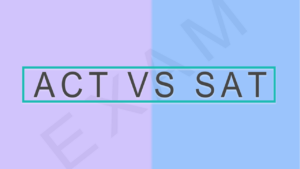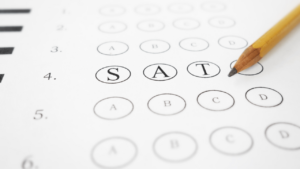Scholastic Assessment Test (SAT) is a standardised exam for students aspiring to continue studying abroad. While the exam evaluates candidates’ knowledge and ability, the pattern of SAT exam determines their readiness for college while serving as a reliable and valid predictor for college outcomes. SAT exam pattern consists of two major sections: EBRW (Evidence-based Reading and Writing), Maths, and an optional essay. These sections’ scores range from 200 to 800 points, while the optional essay section ranges from 2 to 8 points.
Read on to find out more about the SAT exam pattern.
Major Highlights in Pattern of SAT exam
Check out the table below to understand the major highlights of the SAT pattern before further details.
| Section | No. of Questions | Time Allotted (in Minutes) | Score Range (in Points) |
| EBRW (Evidence-based reading and writing) | 96 | 100 | 200 to 800 |
| Mathematics | 58 | 80 | 200 to 800 |
| Essay (optional) | 1 | 50 | 2 to 8 |
| Total (without essay) | 154 | 180 (3 hours) | 400 to 1600 |
With knowledge about some highlights, let us describe these sections in a broader and better way.
Syllabus and Structure of SAT exam
The SAT exam paper runs for 3 hours, excluding the optional essay section. It covers topics and courses that one has studied in the high school curriculum. The SAT exam majorly concerns the two sections EBRW and mathematics, but certain colleges also demand the optional essay section scores during application processes.
Evidence-Based Reading and Writing
SAT EBRW comprises two sections, a reading section and a writing and language section, with an SAT score of 200 to 800. The SAT section score is derived by summing up two EBRW sections’ scores. The EBRW section comprises 96 questions to be attempted with an allotted duration of 100 minutes. This exam primarily focuses on the reading and writing skills of candidates.
Reading Test
The pattern of the reading test is as follows –
- The reading section comprises 52 multiple choice questions with a time limit of 65 minutes.
- This SAT exam pattern consists of 5 passages that are followed by passage specific multiple-choice questions.
- These passages are earlier works published in the literature, social studies, and science books or journals.
- Further, a few of them comprise charts and graphs related to the passages.
- This test highlights an individual’s ability to understand, find and analyse evidence in the passage content.
The table below provides further information on the structure of the SAT reading test.
| Section | Questionnaire Type |
| Reading Test |
|
Writing and Language Test
The pattern for SAT writing and language test is as follows –
- This writing and language test comprises 44 multiple choice questions with a time limit of 35 minutes.
- It consists of 4 passages, with each of them followed by 11 MCQs.
- Further, two passages contain pictorial infographics, charts or graphs incorporated into the textual content.
- The exam’s structure consists of questions that can test a candidate’s knowledge of grammar, rhetoric, style and usage of the English language.
The table below provides further information on SAT writing and language test structure.
| Section | Questionnaire Type |
| Writing and Language Test |
|
Mathematics Test
The SAT mathematics exam comprises two further sections: maths with calculator section and maths with no-calculator section. The structure details of this exam are as follows –
- This test contains 58 questions that are to be attempted in 80 minutes.
- The section score ranges from 200 to 800 that are derived from the scores of these two sections
- 80% of questions are in MCQ format, and 20% are in the form of grid-ins.
Maths with No-calculator
The pattern of maths with no calculator is as follows –
- This section consists of 20 multiple choice questions to attempt in 25 minutes.
- The questions are distributed in 15 MCQs and 5 grid ins.
Maths with Calculator
The pattern of maths with a calculator is as follows –
- This section comprises 38 questions to be attempted in 55 minutes.
- These questions are distributed in 30 MCQs and 8 grid ins.
- Candidates are allowed to bring scientific and graphing calculators for this exam but not mobiles.
The table below provides further information on the structure of SAT Mathematics test.
| Section | Questionnaire Type |
| Mathematics test |
|
SAT Essay Test (Optional)
Though the essay test is optional for the candidates, some colleges still require these SAT essay scores at the time of the admission process. This is done to understand a candidate’s thought process and get a glimpse of their personality insights. Additional fees are charged to take this test, along with the basic SAT registration fee. Further details are as follows –
- Candidates need to write an essay on a specified topic within the allotted time of 50 minutes.
- Further, test takers have to read, understand, and evaluate the specified commentary or speech while also reasoning and rhetoric the author implemented.
- The essay scores are based on three areas: reading, writing, and analysis, which range from 2 to 8 points.
Though every passage differs, the passages in this test follow some similar details pointed out in the table below.
| Section | Questionnaire Type |
| Essay Test |
|
Henceforth, an individual applying for SAT can refer to this article to learn about the pattern of SAT exam. The details mentioned above can help students prepare for this exam in a planned and organised manner. The SAT exam syllabus is designed to evaluate the candidate’s knowledge and skill of real-life applications garnered during high school. These exams are mainly for the students who aspire to study abroad in their dream college in their choice of courses. Furthermore, this exam structure can easily help an individual prepare oneself for the upcoming challenges while studying higher education in colleges abroad.
Frequently Asked Questions
1. Is there a negative mark on SAT?
No, there is no negative SAT marking for incorrect answers. The scores are evaluated by the number of correct answers given by an individual.
2. Can I give SAT after the 12th?
Individuals usually appear for the SAT exam after completing high school. This exam is given by the students interested in enrolling on undergraduate programs abroad.







